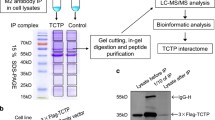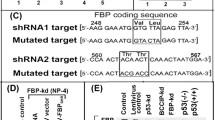Abstract
TIP30 (30 kDa HIV-1 TAT-interacting protein), also called HTATIP2 or CC3, is a tumor suppressor protein that acts as an angiogenesis inhibitor. TIP30 blocks nuclear import of the mRNA-binding protein HuR, and thereby promotes the cytoplasmic accumulation of HuR by binding to importin-β, which is known to facilitate the cytoplasm-tonuclear transport of HuR. Accumulation of HuR in the cytoplasm, in turn, enhances the expression of the transcription factor p53, a tumor suppressor that plays an essential role in preserving genome stability and inhibiting cancer growth. In addition to such a post-transcriptional mechanism via which TIP30 increases the p53 level, it has been proposed that TIP30 may regulate p53 protein at the protein level by directly binding to it. In order to investigate the possibility of direct interaction between p53 and TIP30, we have used on three functional regions in p53 and examined their interactions with TIP30 using GST pull-down assay and surface plasmon resonance technique. The results show that that TIP30 binds to the DNA-binding domain and the C-terminal domain of p53.
Similar content being viewed by others
References
Bell, S., Klein, C., Muller, L., Hansen, S., and Buchner, J. (2002). p53 contains large unstructured regions in its native state. J. Mol. Biol. 322, 917–927.
Chen, J., Marechal, V., and Levine, A.J. (1993). Mapping of the p53 and mdm-2 interaction domains. Mol. Cell. Biol. 13, 4107–4114.
Chi, S.W., Lee, S.H., Kim, D.H., Ahn, M.J., Kim, J.S., Woo, J.Y., Torizawa, T., Kainosho, M., and Han, K.H. (2005). Structural details on mdm2-p53 interaction. J. Biol. Chem. 280, 38795–38802.
Chipuk, J.E., Kuwana, T., Bouchier-Hayes, L., Droin, N.M., Newmeyer, D.D., Schuler, M., and Green, D.R. (2004). Direct activation of Bax by p53 mediates mitochondrial membrane permeabilization and apoptosis. Science 303, 1010–1014.
Csizmok, V., Szollosi, E., Friedrich, P., and Tompa, P. (2006). A novel two-dimensional electrophoresis technique for the identification of intrinsically unstructured proteins. Mol. Cell. Proteomics 5, 265–273.
El Omari, K., Bird, L.E., Nichols, C.E., Ren, J., and Stammers, D.K. (2005). Crystal structure of CC3 (TIP30): implications for its role as a tumor suppressor. J. Biol. Chem. 280, 18229–18236.
Guttinger, S., Muhlhausser, P., Koller-Eichhorn, R., Brennecke, J., and Kutay, U. (2004). Transportin2 functions as importin and mediates nuclear import of HuR. Proc. Natl. Acad. Sci. USA 101, 2918–2923.
Hupp, T.R., Lane, D.P., and Ball, K.L. (2000). Strategies for manipulating the p53 pathway in the treatment of human cancer. Biochem. J. 352, 1–17.
Joerger, A.C., and Fersht, A.R. (2007). Structure-function-rescue: the diverse nature of common p53 cancer mutants. Oncogene 26, 2226–2242.
King, F.W., and Shtivelman, E. (2004). Inhibition of nuclear import by the proapoptotic protein CC3. Mol. Cell. Biol. 24, 7091–7101.
Komlodi-Pasztor, E., Trostel, S., Sackett, D., Poruchynsky, M., and Fojo, T. (2009). Impaired p53 binding to importin: a novel mechanism of cytoplasmic sequestration identified in oxaliplatinresistant cells. Oncogene 28, 3111–3120.
Li, M., Brooks, C.L., Wu-Baer, F., Chen, D., Baer, R., and Gu, W. (2003). Mono-versus polyubiquitination: differential control of p53 fate by Mdm2. Science 302, 1972–1975.
Li, Q., Falsey, R.R., Gaitonde, S., Sotello, V., Kislin, K., and Martinez, J.D. (2007). Genetic analysis of p53 nuclear importation. Oncogene 26, 7885–7893.
Li, X., Zhang, Y., Cao, S., Chen, X., Lu, Y., Jin, H., Sun, S., Chen, B., Liu, J., Ding, J., et al. (2009). Reduction of TIP30 correlates with poor prognosis of gastric cancer patients and its restoration drastically inhibits tumor growth and meta-stasis. Int. J. Cancer 124, 713–721.
Mazan-Mamczarz, K., Galban, S., Lopez de Silanes, I., Martindale, J.L., Atasoy, U., Keene, J.D., and Gorospe, M. (2003). RNAbinding protein HuR enhances p53 translation in response to ultraviolet light irradiation. Proc. Natl. Acad. Sci. USA 100, 8354–8359.
Naski, N., Gajjar, M., Bourougaa, K., Malbert-Colas, L., Fahraeus, R., and Candeias, M.M. (2009). The p53 mRNA-Mdm2 interaction. Cell Cycle 8, 31–34.
NicAmhlaoibh, R., and Shtivelman, E. (2001). Metastasis suppres-sor CC3 inhibits angiogenic properties of tumor cells in vitro. Oncogene 20, 270–275.
Shi, M., Zhang, X., Wang, P., Zhang, H.W., Zhang, B.H., and Wu, M.C. (2005). TIP30 regulates apoptosis-related genes in its apop-totic signal transduction pathway. World J. Gastroenterol. 11, 221–227.
Shtivelman, E. (1997). A link between metastasis and resistance to apoptosis of variant small cell lung carcinoma. Oncogene 14, 2167–2173.
Szklarczyk, D., Franceschini, A., Kuhn, M., Simonovic, M., Roth, A., Minguez, P., Doerks, T., Stark, M., Muller, J., Bork, P., et al. (2011). The STRING database in 2011: functional interaction networks of proteins, globally integrated and scored. Nucleic Acids Res. 39, D561–568.
Tong, X., Li, K., Luo, Z., Lu, B., Liu, X., Wang, T., Pang, M., Liang, B., Tan, M., Wu, M., et al. (2009). Decreased TIP30 expression promotes tumor metastasis in lung cancer. Am. J. Pathol. 174, 1931–1939.
Vogelstein, B., Lane, D., and Levine, A.J. (2000). Surfing the p53 network. Nature 408, 307–310.
Wang, W., Yang, X., Kawai, T., Lopez de Silanes, I., Mazan-Mamczarz, K., Chen, P., Chook, Y.M., Quensel, C., Kohler, M., and Gorospe, M. (2004). AMP-activated protein kinase-regulated phosphorylation and acetylation of importin alpha1: involvement in the nuclear import of RNA-binding protein HuR. J. Biol. Chem. 279, 48376–48388.
Xiao, H., Tao, Y., Greenblatt, J., and Roeder, R.G. (1998). A cofactor, TIP30, specifically enhances HIV-1 Tat-activated transcription. Proc. Natl. Acad. Sci. USA 95, 2146–2151.
Xiao, H., Palhan, V., Yang, Y., and Roeder, R.G. (2000). TIP30 has an intrinsic kinase activity required for up-regulation of a subset of apoptotic genes. EMBO J. 19, 956–963.
Zhao, J., Zhang, X., Shi, M., Xu, H., Jin, J., Ni, H., Yang, S., Dai, J., Wu, M., and Guo, Y. (2006). TIP30 inhibits growth of HCC cell lines and inhibits HCC xenografts in mice in combination with 5-FU. Hepatology 44, 205–215.
Zhao, J., Ni, H., Ma, Y., Dong, L., Dai, J., Zhao, F., Yan, X., Lu, B., Xu, H., and Guo, Y. (2007). TIP30/CC3 expression in breast carcinoma: relation to metastasis, clinicopathologic parameters, and P53 expression. Hum. Pathol. 38, 293–298.
Zhao, J., Chen, J., Lu, B., Dong, L., Wang, H., Bi, C., Wu, G., Guo, H., Wu, M., and Guo, Y. (2008). TIP30 induces apoptosis under oxidative stress through stabilization of p53 messenger RNA in human hepatocellular carcinoma. Cancer Res. 68, 4133–4141.
Author information
Authors and Affiliations
Corresponding authors
About this article
Cite this article
Lee, SH., Ju, SK., Lee, TY. et al. TIP30 directly binds p53 tumor suppressor protein in vitro . Mol Cells 34, 495–500 (2012). https://doi.org/10.1007/s10059-012-0232-x
Received:
Revised:
Accepted:
Published:
Issue Date:
DOI: https://doi.org/10.1007/s10059-012-0232-x




